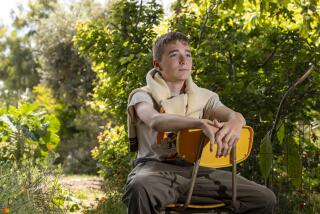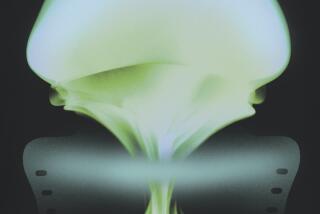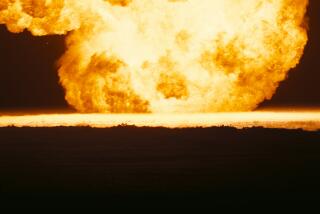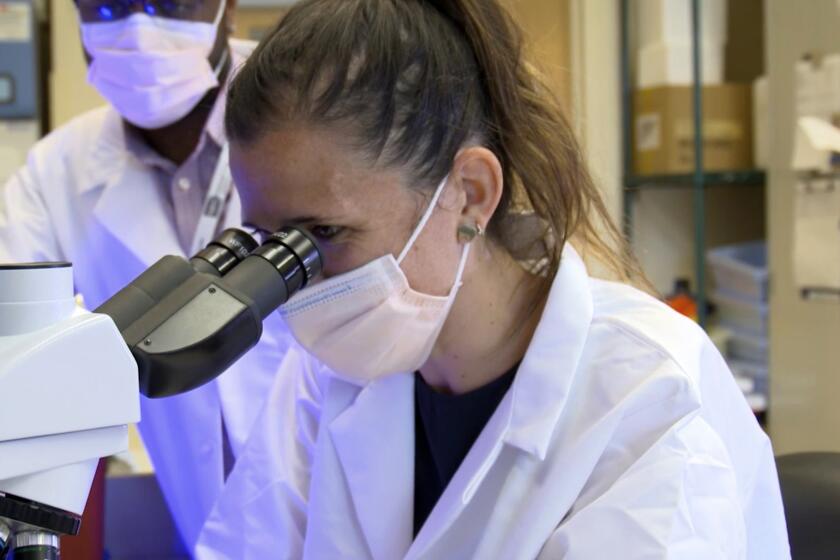Fission Tests 50 Years Ago Fueled Excitement, Relief
- Share via
CHICAGO — As students hustle past Henry Moore’s abstract sculpture “Birth of the Atomic Age” on the University of Chicago campus, many are weighed down only with books.
But at this spot 50 years ago, a much heavier burden faced an elite group of physicists: how to conquer Adolf Hitler--and win World War II.
Brought together by the U.S. government’s super-secret Manhattan Project, the scientists were in Chicago to try to conduct the world’s first self-sustaining, controlled nuclear chain reaction. Their mission: to build a structure that caused neutrons to bombard and split uranium atoms, whereby newly produced neutrons would grow exponentially, sustaining a chain reaction. The process is called fission. Controlled, a new source of energy would result. Uncontrolled, the chain reaction would release explosive energy.
On Dec. 2, 1942, the group gathered on a squash court balcony in a stadium long since demolished. Their leader, Enrico Fermi, fiddled with his slide rule as three scientists stood on a platform above a carefully constructed pile of graphite and uranium.
In the pile were three sets of rods to control the splitting uranium atoms. One rod, manipulated by George Weil, actually held the sustained nuclear reaction in check until withdrawn the proper distance.
At 2:30 p.m. a series of adjustments were made to the heap, called Chicago Pile 1 (CP-1). At 3:25 p.m., Weil received the final recalibration from Fermi. He withdrew the cadmium-plated control rod one last foot.
As 43 scientists watched, the clicks of the neutron counters buzzed too fast for the human ear to count. On a chart, a pen’s upward movement left a straight line. The neutron intensity did not level off. “The reaction is self-sustaining,” announced Fermi. “The curve is exponential.”
The nuclear reaction was a reality, although it would be more than two years before the world was told.
Fermi’s announcement prompted a buzz of controlled excitement in the room, recalls William Sturm, then a second year graduate student at the university. “We all relaxed and smiled. We patted each other on the backs, shook hands and had a little bit of Chianti from (Eugene) Wigner’s bottle and went home a little bit early.”
A decade later, Fermi wrote: “The event was not spectacular, no fuses burned, no lights flashed. But to us it meant that release of atomic energy on a large scale would be only a matter of time.”
There also was a sense of relief. “We wanted to make the bomb before the enemy did,” says Sturm. “We knew a bomb was possible, in fact, couldn’t be avoided. We knew the enemy was working on it.”
Nella Fermi Weiner, Fermi’s daughter, remembers the scientists regrouping that evening at her parents’ home. Only 11 years old, she recalls: “I remember my mother being quite puzzled when people kept coming in and congratulating my father. We didn’t have the foggiest idea of what they were talking about.”
A mixture of satisfaction and tribulation marks the University of Chicago’s weeklong celebration of the event.
“This is not only historical, but also evaluative,” said John Simpson, emeritus professor of physics. Reflecting now on the implications of nuclear power, he says “it’s a whole new world. We have the pluses and the minuses. . . . It’s the way people use it that determines whether it’s beneficial or not.”






